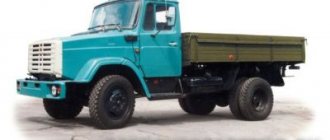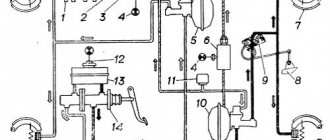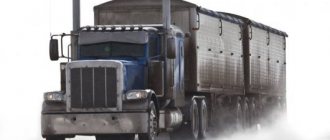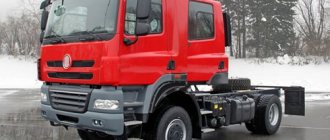- November 25, 2018
- Automobile law
- Epifantseva Anna
Overloaded cars are quite a dangerous phenomenon on the highways. For this reason, the permissible weight of a truck on Russian roads was regulated. In addition, overloaded vehicles lead to high loads on the road surface, which begins to collapse. Therefore, it is important to know what the permissible maximum weight of a truck means. This is a matter of great responsibility. If motorists violate this point, they face fines.
About permissible axial load
In addition to the regulations on which trucks with a permissible maximum weight are allowed to operate on the territory of the country, other regulations apply to this type of vehicle. It concerns the limits of axle loads. This feature is important in calculations.
To understand how the permissible weight of a truck on roads was calculated, it is important to know about the simplest terms.
For machines with 2 axles, the limit is 18 tons, with 3 axles - 25 tons, with 4 axles - 32 tons, with 5 axles - 35 tons. There are also frames for road trains. Thus, the restrictions for 3 axles are 28 tons, 4 axles are 36 tons, 5 axles are 40 tons, and more than 6 axles are 44 tons.
The load is calculated using complex formulas.
Maximum weight of trucks in Europe. Truck axle loads in Europe
| A country | A | B | B.G. | CH | D | DK | E | E.G. | F | G.B. | GR | G.U.S. | H | I | IRL | L | N | NL | P | P.L. | R | S | SF | TR |
| maximum weight for axles (tons) | ||||||||||||||||||||||||
| Non-driving axle | 10 | 10 | 10 | 10 | 10 | 10 | 13 | 10 | 13 | 10,5 | 10 | 10 | 10 | 10 | 10 | 10 | 10 | 10 | 10 | 10 | 10 | 10 | 10 | 13 |
| Drive axle | 11,5 | 12 | — | 11,5 | 11,5 | 11,5 | 11,5 | 11,5 | 13 | 10,5 | 11,5 | — | — | 10 | 10,5 | 11,5-12 | 11 | 11,5 | 12 | — | — | 11,5 | 14,5 | — |
| Double trolley | 16 | 20 | 16 | 18 | 18-19 | 18 | 14-21 | 20 | 21 | 18,3 | 19 | — | 16 | 12-25 | 20,3 | 17-20 | 18 | 11-20 | 19 | 16 | 16 | 18-19 | 16-17 | 19 |
| Triple trolley | 21-24 | 20-30 | — | — | 24 | 24 | 24 | 24 | — | 22,9 | 26 | — | — | 26 | 24 | 24-27 | — | 21-24 | 24 | — | 22 | 21-24 | 21-24 | — |
| total weight of a single truck (tons) | ||||||||||||||||||||||||
| Two axle truck | 18 | 19 | 16 | 16 | 18 | 18 | 20 | 18 | 19 | 16-26 | 18 | 36 | 20 | 18 | 17 | 19 | — | 21,5 | 19 | 16 | 16-17 | 18 | 18 | 19 |
| Three axle truck | 22 | 26 | 26 | 22 | 26 | 26 | 26 | 25-26 | 26 | 26 | 26 | 36 | 24 | 26 | 26 | 26 | — | 28 | 26 | 24 | 22 | 26 | 25-26 | 26 |
| Four axle truck | 32 | 32 | — | — | 32 | 32 | 32 | 32 | 32 | 30-32 | 32 | — | 30 | 32 | 32 | 32 | — | 43 | 32 | — | 24 | 31-32 | 32 | 26 |
| total trailer weight (tons) | ||||||||||||||||||||||||
| Two axle trailer | 18 | 20 | 20 | 12 | 18 | 20 | 20 | 18 | 19 | 16,2 | 18 | — | 20 | 18 | 18 | 18-20 | 20 | 20 | 18 | 16 | 16-17 | 16 | 20 | — |
| Tri-axle trailer | 24 | 30 | 26 | 12 | 24 | 24 | 26 | 24 | 24-26 | 24,4 | 24 | — | 24 | 24 | 24,4 | 24-30 | 28 | 30 | 24 | 24 | 22 | 22 | 30 | 32 |
| total weight of the road train (tons) | ||||||||||||||||||||||||
| Three-axle semi-trailer train | 30 | 29 | 36 | 26 | 28 | 40 | 38 | 28 | 32 | 25-26 | 32 | 36 | 28 | 25 | 25 | 38 | 50 | 30 | 29 | 32 | 30 | — | 44 | 32 |
| Four-axle semi-trailer train | 38 | 39 | 38 | 28 | 36 | 40 | 38 | 36-38 | 38 | 32,5 | 36-38 | 36 | 36 | 32 | 35 | 38 | 50 | 40 | 37 | 32 | 34-36 | — | 44 | 38 |
| Five-axle semi-trailer train | 38 | 44 | 38 | 28 | 40 | 40 | 40 | 40 | 40 | 38-39 | 40 | 36 | 40 | 40 | 40 | 44 | 50 | 50 | 40 | 42 | 40 | 51,4 | 48 | 42 |
| Six-axle semi-trailer train | 38 | 44 | 38 | 28 | 40 | 40 | 40 | 40 | 40 | 38-39 | 40 | 36 | 40 | 40 | 40 | 44 | 50 | 50 | 40 | 42 | 40 | 51,4 | 48 | 42 |
| Four-axle road train | — | — | — | — | — | — | 40 | 36 | — | 32,5-35 | 35 | — | — | 40 | 35 | — | — | — | 37 | — | 31 | — | — | 38 |
| Five-axle road train | 38 | 44 | 38 | 28 | 40 | 40 | 40 | 40 | 40 | 38 | 40 | 36 | 40 | 44 | 40 | 44 | 50 | 50 | 40 | 42 | 40 | 51,4 | 44-48 | 42 |
| Six-axle road train | 38 | 44 | 38 | 28 | 40 | 48 | 40 | 40 | 40 | — | 40 | 36 | 40 | 44 | 40 | 44 | 50 | 50 | 40 | 42 | 40 | 60 | 44-48 | 42 |
| Three axle bus | 22 | 26 | — | 22-25 | 22 | 24 | 24 | 22 | — | 24,4 | 20 | 36 | 24 | 24 | 24 | 26 | — | 24-30 | 26 | 24 | 22 | — | 22 | — |
About roads
It is important to know that the permissible total weight of a truck is calculated taking into account the characteristics of the road surface. Loads are distributed less on the front axles than on the rear axles. It is determined whether the driver has met the permitted gross weight of the truck when the vehicle drives onto the scales at the post. Then the employee of the relevant authority uses a directory with a list of all types of vehicles, where the loads on these parts are described. Depending on the number of axles, the permissible weight of trucks is determined. It is also important to remember that the distance between the axes also plays a role in identifying the norm.
Extreme accuracy plays an important role in the calculation process. The whole point is that the errors should not be more than 5%. The closer the axles are placed, the more powerful the pressure on the road. Therefore, the permissible weight of a truck according to the Transport Transport Code largely depends on this parameter.
Permissible weight of a road train in Russia. Maximum axle load in Russia.
Appendix No. 2 to the Rules for the transportation of goods by road (as amended by Decree of the Government of the Russian Federation No. 12 of January 9, 2014)
Permissible axle loads of vehicles
| Distance between adjacent axes (meters) | Permissible axle loads of wheeled vehicles depending on the standard (calculated) axle load (tons) and the number of wheels on the axle | |||
| for highways designed for an axle load of 6 tons/axle (*) | for highways designed for an axle load of 10 tons/axle | for highways designed for an axle load of 11.5 tons/axle | ||
| Single axes | 5,5 (6) | 9 (10) | 10,5 (11,5) | |
| Twin axles of trailers, semi-trailers, trucks, tractor units, truck tractors with the distance between the axles (load on the bogie, sum of axle masses) | up to 1 (inclusive) | 8 (9) | 10 (11) | 11,5 (12,5) |
| from 1 to 1.3 (inclusive) | 90 (10) | 13 (14) | 14 (16) | |
| from 1.3 to 1.8 (inclusive) | 10 (11) | 15 (16) | 17 (18) | |
| from 1.8 or more | 11 (12) | 17 (18) | 18 (20) | |
| Triple axles of trailers, semi-trailers, trucks, tractor units, truck tractors with the distance between the axles (load on the bogie, sum of axle masses) | up to 1 (inclusive) | 11 (12) | 15 (16,5) | 17 (18) |
| up to 1.3 (inclusive) | 12 (13,5) | 18 (19,5) | 20 (21) | |
| from 1.3 to 1.8 (inclusive) | 13,5 (15) | 21 (22,5 **) | 23,5 (24) | |
| from 1.8 or more | 15 (16) | 22 (23) | 25 (26) | |
| Closed axles of trucks, tractor-trailers, truck tractors, trailers and semi-trailers with more than three axles at a distance between the axles (load per axle) | up to 1 (inclusive) | 3,5 (4) | 5 (5,5) | 5,5 (6) |
| from 1 to 1.3 (inclusive) | 4 (4,5) | 6 (6,5) | 6,5 (7) | |
| from 1.3 to 1.8 (inclusive) | 4,5 (5) | 6,5 (7) | 7,5 (8) | |
| from 1.8 or more | 5 (5,5) | 7 (7,5) | 8,5 (9) | |
| Close axles of vehicles with eight or more wheels on each axle (load per axle) | up to 1 (inclusive) | 6 | 9,5 | 11 |
| from 1 to 1.3 (inclusive) | 6,5 | 10,5 | 12 | |
| from 1.3 to 1.8 (inclusive) | 7,5 | 12 | 14 | |
| from 1.8 or more | 8,5 | 13,5 | 16 | |
( * ) If the owner of the highway installs appropriate road signs and posts information on the axle load of the vehicle permissible for the highway on its official website. ( ** ) For vehicles with single wheels equipped with pneumatic or equivalent suspension.
Notes:
- Values in parentheses are for dual-pitch wheels, outside brackets are for single-pitch wheels.
- Axles with single and dual wheels, combined into a group of adjacent axles, should be considered as adjacent axles with single wheels, with the exception of a two-axle bogie with an unloaded axle.
- For tandem and triple axles structurally combined into a common bogie, the permissible axle load is determined by dividing the total load on the bogie by the appropriate number of axles.
- The permissible axle load for a two-axle cart with an unloaded axle is taken to be equal to the ratio of 60 percent of the permissible load on a two-axle cart for the driving axle and 40% for the unloaded axle.
In other countries
When traveling outside the Russian Federation, you need to remember that in countries around the world this issue is also regulated. However, the approach to it is somewhat different. Fines for violating truck weight regulations can be very large. Among European countries, Spain stands out. It has the smallest permitted weight of trucks.
It is important for every company involved in cargo transportation to become familiar with the legislation of other states. Often, organizations protect each other by discussing transportation conditions among themselves and mentioning the permissible maximum weight of the truck. This helps to avoid many mistakes that partners from other countries can make.
Weighing
There are special points on the highways where cars are weighed. In this way, both the weight of the vehicle and the maximum permitted weight of trucks are checked (this is determined by a specialist), as well as the load on the axles of the vehicle. And there are two methods for determining how overloaded the machine is.
The first way to check whether the weight of a vehicle corresponds to the permitted weight of trucks on Russian roads is static. When using it, the truck drives to the scales and stands on them. The device instantly displays the current weight of the vehicle.
The second way to check whether the weight of a truck meets the established standard is dynamic. In this case, the car moves at low speed. It is this technique that helps not only determine the weight of the truck, but also view the current load on the axles, which is important. When carrying out such a procedure, it is necessary that the vehicle moves at a speed of no more than five kilometers per hour. But this approach has certain disadvantages. Thus, it helps to determine whether the weight of the vehicle corresponds to the permitted weight of trucks on Russian roads, but with certain errors. And you definitely need to remember this. Often the inaccuracy in the results is equal to three percent.
Typically, this procedure involves the use of electronic scales. Entry is via ramps. Several types of scales are installed at a number of posts.
Responsibility
If the permitted weight of trucks on Russian roads is exceeded, the law provides for liability. And while motorists driving passenger cars may not worry about this issue, those driving large trucks need to think about it. The maximum permissible axle load is calculated before the moment the car leaves the assembly line.
Moreover, this point is always reflected in the vehicle documentation. A separate line is devoted to this topic, regulating such a process in the documents. Manufacturers calculate the permissible load levels of their equipment themselves.
And at the same time, the liability for violating this norm is quite serious. The thing is that overloading a car harms normal traffic. Overloaded transport provokes emergency situations. The movement becomes unstable. Loads additionally put pressure on the axles, which may one day not support the mass. Road surfaces are also destroyed due to the movement of overloaded vehicles on them. And at the same time, potholes on road surfaces are a pressing problem throughout Russia, and the presence of fines for overloading does not cover the damage that is caused to the road.
The components of vehicles become unusable much faster; overload leads to accelerated depreciation of the vehicle’s components. The chances that it will break soon increase significantly.
In addition, overloaded cars create additional risks on the roads. Overload lengthens the braking distance. And this is not a complete list of factors that can act as reasons for fines.
Types of cars
Drivers of trucks should keep in mind that in order to determine the required weight of a vehicle, they must first classify the truck as a specific type. They can be large, dangerous and others. Fines for any violations are listed in Article 12 of the Code of Administrative Offenses. They also come in three types: for individuals, fines do not exceed two thousand rubles, for officials - no more than fifteen thousand rubles, and for legal entities - no more than four hundred thousand rubles.
In a number of situations, in order to carry out cargo transportation, it is necessary to obtain the appropriate permission. In its absence, the violator must be fined. Sometimes, if the documentation is completed correctly, but the weight does not coincide with that indicated in the documents, then inspectors can impose fines in the amount of five thousand rubles. For organizations, the fine increases at least fifty times.
But there is one important subtlety. No inspector will issue a fine if he has not first carried out a control weighing procedure. This violation cannot be detected by sight, and the fine will be illegal. It is required that the advantage must be proven.
Maximum dimensions of cargo vehicles
The maximum permitted parameters for heavy-duty transport are established in the agreement of the CIS countries. According to him:
Correct load distribution
- The length of a car, trailer and bus should not exceed 12 m; for an articulated bus this parameter is 18 m, and for a road train - 20 m. Lifting platforms, steps, windshield wipers, and mirrors are not taken into account when calculating the length.
- The width of any vehicle is less than 2.55 m. This does not include lighting fixtures, stairs and steps, platforms, mirrors, tire pressure indicators.
- The permitted height is 4 m, including the body or container.
About passenger cars
The Code of Administrative Offenses says nothing about overloading passenger cars. They are never subject to road weighing procedures. Fines for exceeding the permissible number of passengers in the cabin are provided due to the fact that such a circumstance makes the journey dangerous. This also affects the depreciation of the vehicle, greatly accelerating it. The car skids more often.
Therefore, inspectors issue fines for violating the rules for transporting passengers. It must be remembered that there must be as many passengers as indicated in the documentation.
For the first violation, a warning may be issued; for subsequent violations of the rules, the fine is five hundred rubles; for failure to fasten seat belts, the fine is already a thousand rubles.
Overloading a vehicle is considered a dangerous violation, for this reason it entails liability. Before starting the journey, you must familiarize yourself with the rules. If in some cases responsibility is assigned to the transport organizations that organized the transportation, then ordinary motorists need to bear responsibility personally.
About sizes
The overall size of freight transport is fixed by international standards and regulations of a number of states. The adjustment serves to ensure the safety of movement, safety and integrity of the cargo. The European Union has introduced a simplified system of relevant rules. They are aimed at creating equal conditions and stimulating transport between EU countries. Previously, this set of rules was used to avoid a situation where the size of the cargo did not correspond to the transfer to rail transport.
A 1996 Council Directive of the European Union regulated both the weight and the size of cargo allowed for carriage. Its requirements are observed in all EU member states. However, the laws of each country may change the prohibitions and rules in one way or another.
There are certain marks of conformity. They are issued taking into account the car’s exhaust level, the noise it makes, and so on. Each sign assigned to a cargo vehicle must be confirmed by appropriate certificates. Signs are received on board vehicles. Examples of such signs: “EURO-3 safe”, “EURO-4”, “EURO-5” and so on.
European emission standards for diesel truck engines
UN General Assembly emission requirements for heavy trucks equipped with a diesel engine, g/(kW • h) Each truck must be marked in accordance with its standard. Letters of the Latin alphabet are used for designation.
| Standard (year) | Carbon monoxide - CO | Hydrocarbons – HC | Nitric oxide – N0x | Soot – PM | Smokiness – Smoke |
| Euro 0 (1988) | 11,2 | 2.4 | 14,4 | — | — |
| Euro 1 (1992) | 4,5 | 1,1 | 8,0 | 0,36 | — |
| Euro 2 (1996) | 4,0 | 1,1 | 7,0 | 0,15 | — |
| Euro 3 (2000) | 2,1 | 0,66 | 5,0 | 0.10 | 0,8 |
| Euro 4 (2005) | 1,5 | 0,46 | 3,5 | 0,02 | 0,5 |
| Euro 5 (2008) | 1,5 | 0,46 | 2,0 | 0,02 | 0,5 |
| Euro 6 (2013) | 1,5 | 0,13 | 0,5 | 0,01 |
A vehicle that meets the relevant requirements is indicated by a letter placed on the cab or bumper of the truck:
- U – “Umwelt” (“Nature”), Euro-1 standard,
- E – “Green Lorry” (“Green Truck”). The concept of “Green Lorry” includes the following requirements: pollutant emission standards EURO-2, noise standards - 78-80 dBA. A certificate of conformity is filled out on such a truck and a U or E plate is installed.
- S – “Supergreen” (“Very green”), Euro-2 standard
- G - "Greener and Safe Lorry"
- L - "Larmarm Kraftfahzeuge" (low noise tractor) in Austria, since December 1, 1989, a truck driving at night (from 22:00 to 5:00) in Austria must comply with these noise standards.
Since 2001, another definition of a motor vehicle has been introduced - “EURO-3 safe”, it has been in force since 2002. Such a truck must comply with EURO-3 emissions standards, and the usual noise level is 78-80 dBA. Then a green sign with a white border and a white number 3 is hung. For cars that comply with “EURO-4” and “EURO-5” the signs are green with a white border and the numbers 4 and 5.
All of the above signs must be confirmed by a certificate from the manufacturer and be on board the vehicle.
regulations
In the Federal Law on highways and on road activities in the Russian Federation and on amendments to certain legislative acts of the Russian Federation, instead of the terms “heavy and large-sized cargo”, the terms “heavy vehicle” and “large-sized vehicle” are used.
The Federal Law prohibits the movement on the road of heavy and large vehicles that transport indivisible cargo. The exception is for vehicles that are driven on the basis of a special permit issued to large vehicles. At the same time, the dimensions of these vehicles should not exceed the permissible norm by more than two percent.
The Federal Law improves the procedures related to the issuance of special permits for the movement of heavy or large vehicles on the road surface. Separate regulations apply to the transport of dangerous goods.
Vehicles engaged in dangerous cargo transportation are entitled to a special permit. It is issued by Rostransnadzor of the Russian Federation.
The regulatory documents stipulate that official bodies issue special permits for the movement of heavy and large vehicles on the road. This is done by contacting authorized institutions. In addition, the Federal Law provides the opportunity to move on the road surface for heavy, large-sized vehicles, the weight of which, both with and without cargo, does not exceed by 2% the legal vehicle mass standards or the permissible axle loads without special permission.
When the axle loads become two percent more than permissible, but not more than ten percent, a special permit is issued according to a simplified scheme. The Federal Law establishes a rule according to which special permits are issued for a period of no more than one day from the moment payment was confirmed to compensate for damage caused by a large machine. In cases where the deadlines for coordinating the route of heavy vehicles or the deadlines for issuing special permits or unjustified refusals to approve the route are violated, the Federal Law provides for administrative liability for the violator.
Maximum truck load capacity
The tonnage of a heavy-duty vehicle directly depends not only on the brand of the tractor, but also on the type of semi-trailer, as well as the number of axles. The standard option is a Euro truck with the following data :
- rear axles – 2 or 3;
- length – 13.6 m;
- width – 2.45 m;
- height – 2.6 m.
Weight restrictions for “European trucks” in the Russian Federation depend on the number of wheel axles. In the standard version, when an empty truck with a trailer weighs 14 tons, the loading is regulated to 24 tons.
The accompanying documents for the cargo indicate the maximum load so that traffic police inspectors at control points equipped with scales can determine the excess.
Weight control point for heavy-duty transport
Important! When transportation of oversized cargo is required, you must obtain permission from the relevant organization. For example, with a road train weighing 80 tons, traffic police representatives draw up a separate route, taking into account the permitted load on sections of the route and bridges.
About history
Among the main pieces of legislation that have imposed restrictions on the size of goods vehicles is the EU Council Directive. And the first countries to change regulations in this area were Sweden and Finland. In these states, the movement of two types of road trains is allowed:
- those that are formed from a tractor with 3 axles;
- those made on the basis of a semi-trailer with 3 axles.
Road trains have been appearing on Russian roads for a long time. They travel between the two capitals of the country and Scandinavia. At the moment, the volume of these road trains should reach 160 cubic meters.
The Scandinavian countries have come a long way until the length of road trains began to be 25.5 meters. At first, only cargo vehicles up to 24 meters long were put into operation.
In North America, semi-trailers have never been made longer than 16 meters and width more than 2.5 meters. In European countries, restrictions were even more stringent. The length of such vehicles should not exceed 13.6 meters, and the width - 2.5 meters. Due to these disagreements internationally, difficulties have arisen in choosing the standards in accordance with which cargo transportation is carried out. For example, 53-foot containers do not appear in European countries, but in the USA and Canada they have become extremely popular.
Acceptable truck sizes in Europe
| A country | A | B | B.G. | CH | D | DK | E | E.G. | F | G.B. | GR | G.U.S. | H | I | IRL | L | N | NL | P | P.L. | R | S | SF | TR |
| dimensions (meter) | ||||||||||||||||||||||||
| Height | 4 | 4 | 4 | 4 | 4 | 4 | 4 | 4 | 4 | 4,2 | 4 | 4 | 4 | 4 | 4,25 | 4 | — | 4 | 4 | 4 | 4 | 4,5 | 4 | 4 |
| Width (standard truck) | 2,5 | 2,55 | 2,5 | 2,5 | 2,5 | 2,55 | 2,55 | 2,5 | 2,55 | 2,5 | 2,55 | 2,5 | 2,5 | 2,55 | 2,5 | 2,6 | 2,55 | 2,6 | 2,55 | 2,5 | 2,5 | 2,6 | 2,6 | 2,5 |
| Width (reefer) | 2,6 | 2,6 | 2,5 | 2,6 | 2,6 | 2,6 | 2,6 | 2,6 | 2,6 | 2,6 | 2,6 | 2,5 | 2,5 | 2,6 | 2,6 | 2,6 | 2,6 | 2,6 | 2,6 | 2,5 | 2,6 | 2,6 | 2,6 | 2,5 |
| Truck length | 12 | 12 | 12 | 12 | 12 | 12 | 12 | 12 | 12 | 12 | 12 | 12 | 12 | 12 | 12 | 12 | 12,4 | 12 | 12 | 12 | 12 | 12 | 12 | 10 |
| Trailer length | 12 | 12 | — | — | 12 | — | 12 | 12 | 12 | 12 | — | — | — | 12 | 12 | 12 | 12,4 | — | 12 | 12 | 12 | 12 | 12,5 | 16 |
| Truck train length | 16 | 16,5 | 16,5 | 16,5 | 16,5 | 16,5 | 16,5 | 16,5 | 16,5 | 16,5 | 16,5 | 20 | 16 | 16,5 | 16,5 | 16,5 | 17 | 16,5 | 16,5 | 16,5 | 16,5 | 24 | 16,5 | 16 |
| Train length | 18 | 18,75 | 22 | 18,35 | 18,75 | 18,5 | 18,75 | 18,75 | 18,75 | 18 | 18,75 | 20 | 18 | 18,75 | 18,75 | 18,75 | 18,5 | 18,75 | 18,75 | 18 | 18,75 | 24 | 18,75 | 18 |
| Three axle bus length | 12 | 12 | 12 | 12 | 12 | 12 | 12 | 12 | 12 | 12 | 12 | 20 | 12 | 12 | 12 | 12 | 12,4 | 12 | 12 | 12 | 12 | 12 | 14,5 | 12 |
| Articulated bus length | 18 | 18 | 16,5 | 16 | 16,5 | — | 18 | — | 16,5 | 18 | 18 | 20-24 | 18 | — | — | 18 | 18 | 18 | — | 22 | 18 | — | 14,5 | 18 |
About road trains
A road train is a vehicle that has an arbitrary number of trailers or tractors. In fact, a road train is a combined vehicle that consists of a truck and a trailer, a tractor with a semi-trailer.
A characteristic feature of these vehicles is that they are equipped with towing devices. The use of a road train allows you to fully realize the enormous potential that cars do not have, reduces the cost of cargo transportation, and improves efficiency. The need for personnel is also reduced, and gasoline consumption is reduced. This is achieved by increasing the maximum level of permissible weight of cargo that is transported simultaneously using freight vehicles.
Terms used in transport documents
- “Truck” is a vehicle equipped with a mechanical drive. Operated for transporting goods by road;
- “Vehicle” is a device on which cargo or passengers are installed for their transportation on roads;
- “Road train” is a combined vehicle consisting of a truck and trailer (trailer train), tractor and semi-trailer (trailer train);
- “Tractor” – a vehicle equipped with its own engine and intended exclusively or primarily for towing a trailer or semi-trailer;
- “Combined vehicle” – a combination of a car and a trailer (semi-trailer);
- “Full trailer” trailer with drawbar - a towed vehicle having at least two axles, of which at least one axle is steerable and, in addition: - equipped with a towing device (drawbar) that has the ability to be vertical in relation to to the moving tractor; - not transmitting any significant vertical load to the tractor (no more than 100 daN). When a semi-trailer is coupled to a semi-trailer undercarriage, it is considered a full trailer;
- “Semi-trailer” is a towed vehicle that is designed to be connected to a truck tractor (or to the support bogie of a semi-trailer) and transfers a significant vertical load to the tractor’s coupling device (or to the support bogie of a semi-trailer);
- “Semi-trailer undercarriage” – A trailer with a center axle and equipped with a fifth-wheel hitch.
- “Maximum length of a vehicle” – the length of a vehicle that does not exceed the established permissible values (different for each country);
- “Maximum vehicle width” – the width of the vehicle, which does not exceed the established permissible values (different for each country);
- “Maximum height of the vehicle” – the height of the vehicle, which does not exceed the established permissible values (different for each country);
- “Maximum vehicle weight” – the weight of a vehicle with or without cargo, which does not exceed the established permissible values (different for each country);
- “Maximum axle mass” – the mass transmitted through the vehicle axle to the surface of the road, which does not exceed the established permissible values (for each country);
- “Weight of a vehicle in running order” is the weight of an unladen vehicle with a body and a coupling device in the case of a tractor-bus, or the weight of a chassis with a cab, if the manufacturer does not install a body, and/or a coupling device. This weight includes coolant, oils, at least 90% fuel, 100% other fluids (excluding used water), tools, driver (75 kg), and spare tire.
- “Technically permissible maximum weight of a vehicle” is the maximum weight of a vehicle, determined by its design and specified characteristics, established by the vehicle manufacturer.
- “Indivisible cargo” – cargo that cannot be divided during transportation due to the risk of damage or high costs of time and money;
- “Air suspension” is a suspension system in which the shock-absorbing element is air, providing at least 75% of the shock-absorbing effect;
Types of freight transport
Freight transport is divided into many types. Semi-trailers are the most common type. They are used almost always when it is necessary to transport cargo of any type. The body can be loaded from any side, which is very convenient. The procedure becomes extremely simple.
Refrigerators are vehicles equipped with a refrigeration unit. Vehicles of this type are used when it is necessary to transport products that quickly deteriorate.
Automatic hitches are vehicles with trailers attached to them. They are very convenient to use during loading and unloading. They are contacted when there is a need to transport any product, with the exception of long cargo or those that require special conditions.
There are also Jumbo trailers. Their characteristic feature is increased capacity. The floors in the trailer are made in the shape of an “L”, they are distinguished by the small diameter of the wheels. This allows you to increase the space in them.
Container ships are vehicles that are used to transport containers.
Tankers are vehicles that transport liquid and bulk cargo.
Car transporters are used to transport cars.
Grain trucks are used when there is a need to transport grain.
Dump trucks are vehicles used for transporting bulk cargo.











